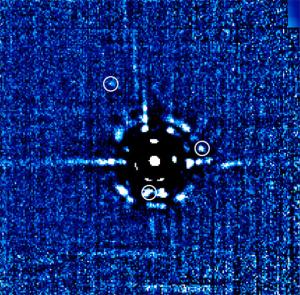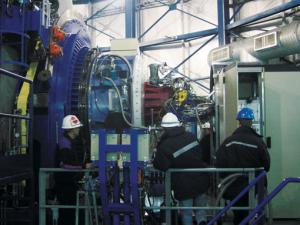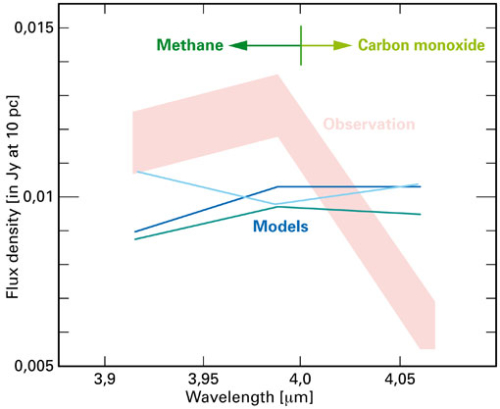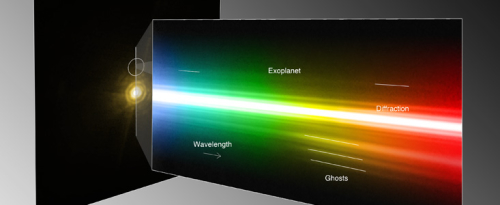|

|
|
Image of the HR 8799 system. In the center, the host star HR 8799. Further investigation shows that three of the specks surrounding the star are planets (marked): Starting at 11 o'clock, clockwise: HR 8799b, HR8799c and HR8799d. The other specks and patterns are artefacts, which are unavoidable in a challenging observation like this one - star and planets are extremely close, and the star is a few thousand times brighter than the planets. (Hi-res version in the MPIA press release, see the URL below.)
[Image source: MPIA/W. Brandner]
|
|

|
|
The NaCo instrument, mounted at ESO's Very Large Telescope on Paranal in Chile. NaCo is a combination of adaptive optics (which counteracts some of the blurring effect of the Earth's atmosphere) and the camera/spectrograph CONICA, which was developed at the Max Planck Institute for Astronomy and the Max Planck Institute for Extraterrestrial Physics.
[Credit: ESO]
|
The research team, which includes three researchers from the Max Planck Institute for Astronomy (MPIA) and two from Canadian universities, studied the planetary system around the bright, very young star HR 8799, 130 light-years from Earth, located within the constellation Pegasus. The planetary system resembles a scaled-up version of our own Solar System and includes three giant planets, which had been detected in 2008 in another study. "Our target was the middle planet of the three, which is roughly ten times more massive than Jupiter and has a temperature of about 800 degrees Celsius," says team member Carolina Bergfors (MPIA), who participated in the observations as part of her PhD work. The researchers recorded the spectrum using the NACO instrument installed at the European Southern Observatory's Very Large Telescope (VLT) in Chile, in particular its combined camera/spectrograph CONICA, which was developed at the MPIA and at the Max Planck Institute for Extraterrestrial Physics. As the host star is several thousand times brighter than the planet, and the two are very close, obtaining such a spectrum is an immense feat. Markus Janson of the University of Toronto, lead author of the paper reporting the new findings, explains: "It's like trying to see what a candle is made of, by observing it next to a blinding 300 Watt lamp - from a distance of 2 kilometres [1.3 miles]." Carolina Bergfors (MPIA), whose work on this project is part of her PhD studies, adds: "It took more than five hours of exposure time, but we were able to tease out the planet's spectrum from the host star's much brighter light." In time, the astronomers hope that this technique will help them gain a better understanding of how planets form. As a first step, they aim to record the spectra of the two other giant planets orbiting HR 8799 - which would represent the first time that astronomers would be able to compare the spectra of three exoplanets that form part of one and the same system. As a much more distant goal, the technique will allow astronomers to examine exoplanets for habitability, or even signs of life. More immediately, the results pose something of a challenge to current models of the exoplanet's atmosphere. "The features observed in the spectrum are not compatible with current theoretical models," explains MPIA's Wolfgang Brandner, a co-author of the study. "We need to take into account a more detailed description of the atmospheric dust clouds, or accept that the atmosphere has a different chemical composition than previously assumed."
|
 |
|
A smoothed-out version of
the spectrum that allows a comparison between theory and
observation. The horizontal direction indicates wavelength, the
vertical direction "flux density" (a measure of how much
radiation reaches us from the planet at the wavelengths
indicated). Clearly, compared with the prediction of the models,
more radiation is received at shorter infrared wavelengths
(left-hand side), and less radiation at longer wavelengths
(right-hand side). This indicates that the models need to be
rethought.
[Image credit: MPIA] |
Questions & Answers
What is a spectrum? As every rainbow demonstrates, white light can be split up into different colors. Astronomers artificially split up the light they receive from distant objects into its different colors (or “wavelengths”). However, where we distinguish five or six rainbow colors, astronomers map hundreds of finely nuanced colors, producing a spectrum – a record of the different amounts of light the object emits in each narrow color band. Also, where we see only a rainbow's visible light, astronomers probe other region of the electromagnetic spectrum. The spectra used here were obtained in the infrared region. The spectrum's properties – more light emitted at some colors, less light at others – provide tell-tale signs about the chemical composition of the matter producing the light. Infrared spectra are especially useful for identifying the presence of molecules. All in all, this makes spectroscopy, the recording of spectra, a key tool for astronomy: Spectra tell us what distant astronomical objects are made of.
What is new about this result? This is the first spectrum that was directly measured for an exoplanet orbiting a Sun-like star. Most previous measurements relied on indirect measurements (watching an exoplanet pass directly behind its host star in an “exoplanetary eclipse”, and extracting the spectrum by comparing the light of the star before and after). One previous direct measurement was on a system involving an object that is either a Brown Dwarf (a “failed star” – an object that is not massive enough to become a star, but too massive to be a planet) or a very dim young star. Other direct measurements produced not a proper spectrum, but merely information about one very small sliver of a spectrum (a particular “spectral line”), conjecturally assigned to a star's exoplanet.
How does this help in the search for life on other planets? This kind of spectroscopic measurement – only much more accurate than in this case! – will be needed to determine whether an exoplanet is suitable for harbouring life as we know it. This determination would be made by looking at the chemical composition of the planet's atmosphere. Furthermore, such studies could reveal indirect signs of existing life: The abundances of different molecules in a planet's atmosphere are regulated by the laws of chemistry. Certain deviations from these standard abundances indicate the presence of life-forms that process chemicals – for instance, the current abundance of oxygen in the Earth's atmosphere is mainly due to the activity of algae, more than 2 billion years ago. We still have a long way to go to find life on exoplanets – from the detection of smaller, more Earth-like planets to the development of more precise spectroscopic measurement techniques. But the technique pioneered here brings us an important step close to our goal.
What are the specific results? The team was able to determine the spectrum of the planet – spatially distinct from the spectrum of the star – in the wavelength region between 3.88 and 4.08 micrometres. The spectrum is very noisy; taking an average ("smoothing") suppresses the noise and allows a comparison with the spectra predicted by theoretical models. Due to the noise, no spectral lines could be resolved. However, the comparison between the smoothed-out spectra shows a clear deviation between the observed spectral shape and that predicted by the current standard models, which assume chemical equilibrium between the different chemical elements present in the atmosphere, and a continuous temperature profile (hotter layers below colder layers). At longer wavelengths (above 4 micrometres), the planet is significantly fainter than expected, which points to molecular absorption in its atmosphere. The simplest explanation is that the atmosphere contains less methane and more carbon monoxide than previously assumed.
What does the HR 8799 system look like? The star Hr 8799 has 1.5 times the mass of the Sun. Three giant companion planets were detected in 2008 by another team of researchers; they have masses between 7 and 10 times that of Jupiter. Their distances from their host star are between 20 and 70 times the Earth-Sun distance. The system also features two belts populated by smaller objects, similar to our Solar System's asteroid and Kuiper belts.
What telescopes were used to obtain these results? The spectra were taken with the infrared instrument NACO, mounted on the Very Large Telescope (VLT) of the European Southern Observatory, in Chile. The measurements relied heavily on the extraordinary capabilities of the instrument's adaptive optics system, which corrects most of the blurring which occurs as light from astronomical objects passes through the Earth's turbulent atmosphere (which is visible to the naked eye as the stars' twinkling). Preparatory data were taken with the IRCS instrument at the Subaru telescope.
What does “HR 8799” stand for? HR 8799 is star number 8799 in the Yale Bright Star Catalogue. The designation “HR” is a legacy of the Bright Star Catalogue's predecessor, the Harvard Revised Photometry Catalogue.
ESO press release:
VLT Captures First Direct Spectrum of an Exoplanet
By studying a triple planetary system that
resembles a scaled-up version of our own Sun’s family of planets,
astronomers have been able to obtain the first direct spectrum - the
“chemical fingerprint” [1] - of a planet orbiting a distant star [2],
thus bringing new insights into the planet's formation and
composition. The result represents a milestone in the search for life
elsewhere in the Universe.
|
 |
|
Spectrum of the exoplanet
around HR 8799 [credit: ESO] |
“The spectrum of a planet is like a fingerprint. It
provides key information about the chemical elements in the planet’s
atmosphere,” says Markus Janson, lead author of a paper reporting the
new findings. “With this information, we can better understand how the
planet formed and, in the future, we might even be able to find
tell-tale signs of the presence of life.”
The researchers obtained the spectrum of a giant
exoplanet that orbits the bright, very young star HR 8799. The system
is at about 130 light-years from Earth. The star has 1.5 times the
mass of the Sun, and hosts a planetary system that resembles a
scaled-up model of our own Solar System. Three giant companion planets
were detected in 2008 by another team of researchers, with masses
between 7 and 10 times that of Jupiter. They are between 20 and 70
times as far from their host star as the Earth is from the Sun; the
system also features two belts of smaller objects, similar to our
Solar System's asteroid and Kuiper belts.
“Our target was the middle planet of the three,
which is roughly ten times more massive than Jupiter and has a
temperature of about 800 degrees Celsius,” says team member Carolina
Bergfors. “After more than five hours of exposure time, we were able
to tease out the planet's spectrum from the host star's much brighter
light.”
This is the first time the spectrum of an exoplanet
orbiting a normal, almost Sun-like star has been obtained directly.
Previously, the only spectra to be obtained required a space telescope
to watch an exoplanet pass directly behind its host star in an
“exoplanetary eclipse”, and then the spectrum could be extracted by
comparing the light of the star before and after. However, this method
can only be applied if the orientation of the exoplanet’s orbit is
exactly right, which is true for only a small fraction of all
exoplanetary systems. The present spectrum, on the other hand, was
obtained from the ground, using ESO’s Very Large Telescope (VLT), in
direct observations that do not depend on the orbit’s orientation.
As the host star is several thousand times brighter than the planet,
this is a remarkable achievement. “It's like trying to see what a
candle is made of, by observing it from a distance of two kilometres
when it’s next to a blindingly bright 300 Watt lamp,” says Janson.
The discovery was made possible by the infrared
instrument NACO, mounted on the VLT, and relied heavily on the
extraordinary capabilities of the instrument’s adaptive optics system
[3]. Even more precise images and spectra of giant exoplanets are
expected both from the next generation instrument SPHERE, to be
installed on the VLT in 2011, and from the European Extremely Large
Telescope.
The newly collected data show that the atmosphere
enclosing the planet is still poorly understood. “The features
observed in the spectrum are not compatible with current theoretical
models,” explains co-author Wolfgang Brandner. “We need to take into
account a more detailed description of the atmospheric dust clouds, or
accept that the atmosphere has a different chemical composition from
that previously assumed.”
The astronomers hope to soon get their hands on the
fingerprints of the other two giant planets so they can compare, for
the first time, the spectra of three planets belonging to the same
system. “This will surely shed new light on the processes that lead to
the formation of planetary systems like our own,” concludes Janson.
Notes
|
[1] |
As every rainbow demonstrates, white light
can be split up into different colours. Astronomers artificially
split up the light they receive from distant objects into its
different colours (or “wavelengths”). However, where we
distinguish five or six rainbow colours, astronomers map
hundreds of finely nuanced colours, producing a spectrum - a
record of the different amounts of light the object emits in
each narrow colour band. The details of the spectrum - more
light emitted at some colours, less light at others - provide
tell-tale signs about the chemical composition of the matter
producing the light. This makes spectroscopy, the recording of
spectra, an important investigative tool in astronomy. |
|
[2] |
In 2004, astronomers used NACO on the VLT to
obtain an image and a spectrum of a 5 Jupiter mass object around
a brown dwarf - a “failed star”. It is however thought that the
pair probably formed together, like a petite stellar binary,
instead of the companion forming in the disc around the brown
dwarf, like a star–planet system (see ESO 28/04, ESO 15/05 and
ESO 19/06). |
|
[3] |
Telescopes on the ground suffer from a
blurring effect introduced by atmospheric turbulence. This
turbulence causes the stars to twinkle in a way that delights
poets but frustrates astronomers, since it smears out the fine
details of the images. However, with adaptive optics techniques,
this major drawback can be overcome so that the telescope
produces images that are as sharp as theoretically possible,
i.e. approaching conditions in space. Adaptive optics systems
work by means of a computer-controlled deformable mirror that
counteracts the image distortion introduced by atmospheric
turbulence. It is based on real-time optical corrections
computed at very high speed (several hundreds of times each
second) from image data obtained by a wavefront sensor (a
special camera) that monitors light from a reference star. |
|
|
|
|
- |
This research was presented in a paper in
press as a Letter to the Astrophysical Journal (“Spatially
resolved spectroscopy of the exoplanet HR 8799 c”, by M. Janson
et al.). |
|
- |
The team is composed of M. Janson (University
of Toronto, Canada), C. Bergfors, M. Goto, W. Brandner
(Max-Planck-Institute for Astronomy, Heidelberg, Germany) and D.
Lafrenière (University of Montreal, Canada). Preparatory data
were taken with the IRCS instrument at the Subaru telescope. |
|
- |
ESO, the European Southern Observatory, is
the foremost intergovernmental astronomy organisation in Europe
and the world’s most productive astronomical observatory. It is
supported by 14 countries: Austria, Belgium, the Czech Republic,
Denmark, France, Finland, Germany, Italy, the Netherlands,
Portugal, Spain, Sweden, Switzerland and the United Kingdom. ESO
carries out an ambitious programme focused on the design,
construction and operation of powerful ground-based observing
facilities enabling astronomers to make important scientific
discoveries. ESO also plays a leading role in promoting and
organising cooperation in astronomical research. ESO operates
three unique world-class observing sites in Chile: La Silla,
Paranal and Chajnantor. At Paranal, ESO operates the Very Large
Telescope, the world’s most advanced visible-light astronomical
observatory, and VISTA, the world’s largest survey telescope.
ESO is the European partner of a revolutionary astronomical
telescope ALMA, the largest astronomical project in existence.
ESO is currently planning a 42-metre European Extremely Large
optical/near-infrared Telescope, the E-ELT, which will become
“the world’s biggest eye on the sky”.
|
|